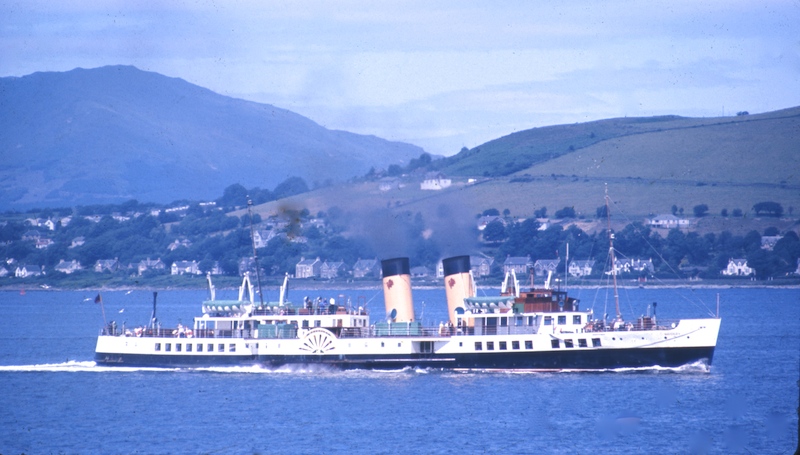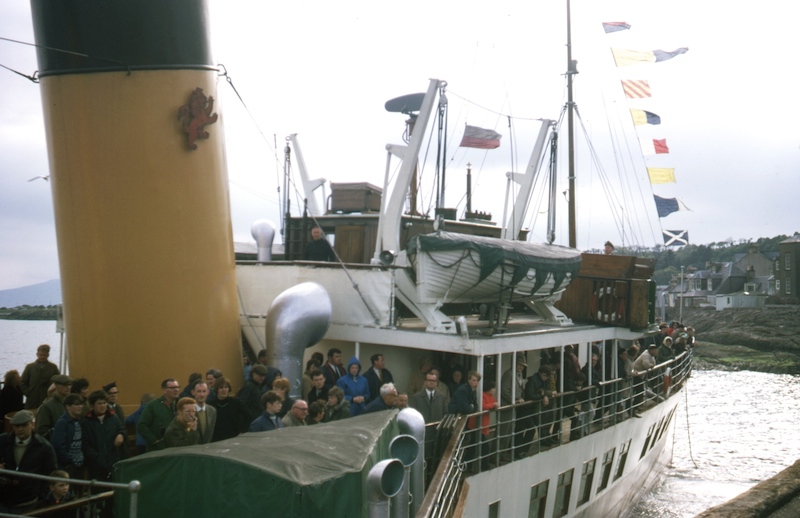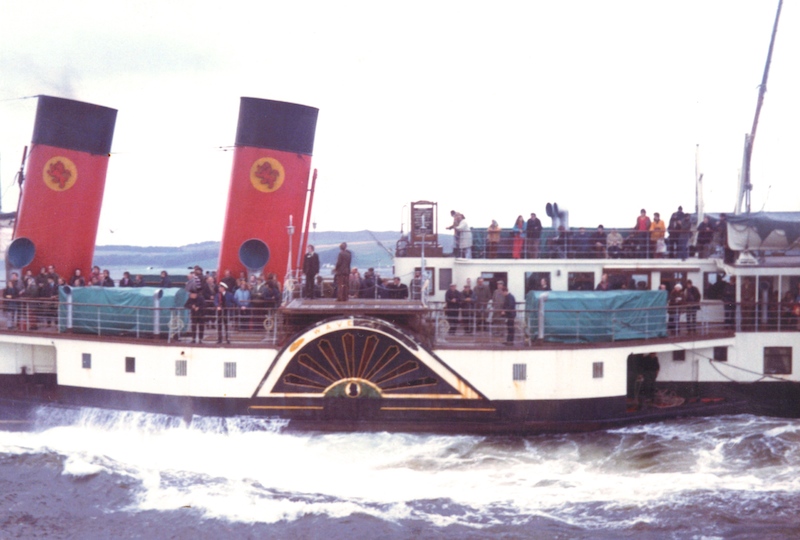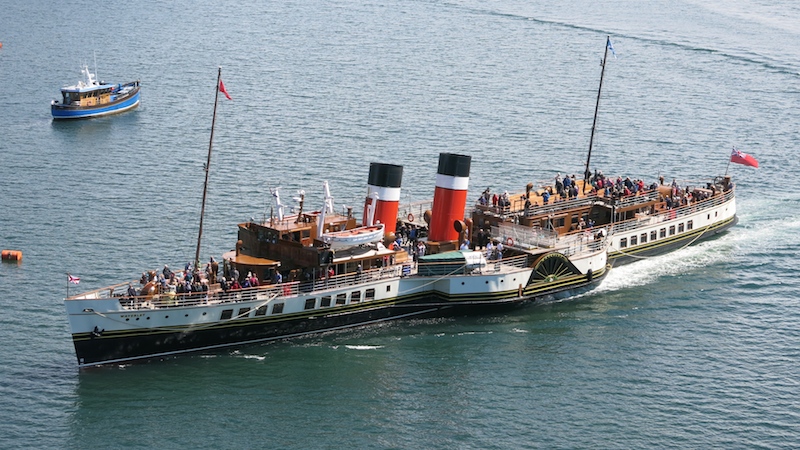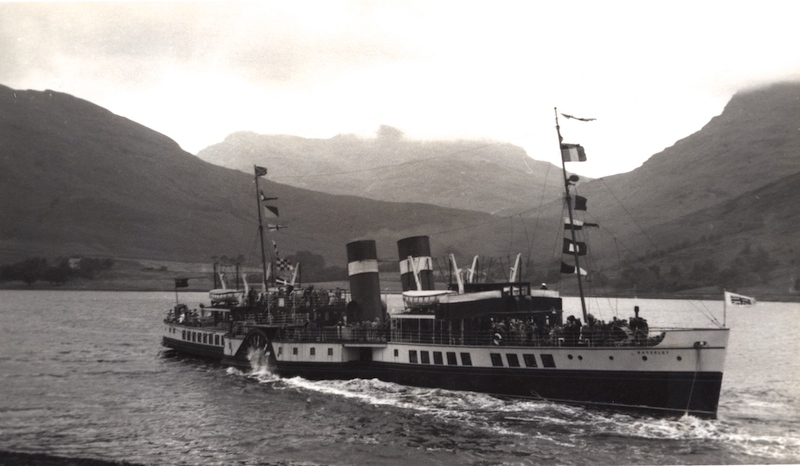
A lifetime ago: Waverley leaves Lochgoilhead on her maiden voyage on 16 June 1947. Copyright CRSC Archive Collection
Today is a special day for Waverley. June 16 is not just the date on which she begins her summer season on the Clyde, but also the 70th anniversary of her maiden voyage to Arrochar in 1947. Waverley’s continuing presence on the shipping scene represents a remarkable achievement by all who have contributed to her wellbeing, past and present. Walter Bowie served as Assistant, Second and Relief Purser in four of the ship’s seven decades. Here he pays tribute to the last working example of that noble genre, the Clyde steamer.
Who amongst us could ever have imagined a postwar paddle steamer still being in active service 70 years after her maiden voyage? Even more unimaginable is that our beloved Waverley has seen 42 years in service since entering the preservation era.
She was purpose-built in 1947 for the Arrochar run from Craigendoran, a ‘suburb’ of Helensburgh. Her maiden voyage was on 16 June 1947.

At Arrochar on 25 June 1949, now with yellow funnels but still with ‘scumbled’ deckhouses. Copyright CRSC Archive Collection
As the North Bank piers on the Clyde are in relatively shallow waters, she was designed as a shallow drafted steamer. Her passenger complement of 1,350 was adequate but, with a limit of only 571 on Outer Firth sailings, she was not so suitable for the longer cruises, although her good speed made her suitable in other respects. In the 1960s she often replaced, for a few weeks towards the end of some seasons, the more expensive-to-operate turbine steamers on the long distance sailings from Gourock.
Waverley was never as popular a steamer as Caledonia, 13 years her senior, but after the latter’s withdrawal at the end of the 1969 season Waverley gained tremendously in popularity, as she was then recognised initially as the last sea-going paddle steamer in Britain – then in Europe – and soon thereafter in the world.
By the end of the 1973 season it seemed that Waverley’s days were numbered. However, in 1974 her owners, Caledonian MacBrayne, made the magnanimous gesture of ‘donating’ their redundant paddle steamer to the Paddle Steamer Preservation Society: August 8th of that year was a momentous date. So an exciting new chapter in the ship’s life began. It is truly amazing that, after sailing for only 27 years in her ‘first’ life, she has managed a further 43 — and let’s hope many more still to come!
Everyone now recognises the distinctive red funnels with white bands and black tops which our paddler has sported – as in her first year – since the beginning of the preservation era. Since various alterations have been made to her, her passenger certificate numbers have changed significantly from her earlier days. She now carries 860 passengers (Class 4 and 5, sheltered waters and the Thames) and 740 (Class 3, seagoing excursions), with a minimum crew of 19 (up to 24 on the Clyde).

Preservationists: Douglas McGowan hands a £1 note to Colonel Patrick Thomas, chairman of the Scottish Transport Group, at James Watt Dock, Greenock, on 8 August 1974 to secure the paddler’s future. John Whittle, CalMac’s managing director, stands on the right. On the left is Terry Sylvester, a pivotal member of the team that saved Waverley.
A trip on Waverley is a step back in time, when young and old can marvel at her magnificent steam engines which are open to public view and wonderment.
In 1977, at the age of 30, Waverley left her home waters for the first time. This was just for a few days, taking part in special events in North Wales and Merseyside. It gave her a taste for venturing even further afield, and since then Waverley has visited big ports in Humberside, the Tyne and the Forth, and become a regular visitor to Southampton and the Solent, and to the Thames, where she gives several sailings each autumn from London. She has revived paddle steamer sailings on the Bristol Channel and around the Isle of Wight.
Waverley’s visits to several islands in the Outer and Inner Hebrides were the first by any purely excursion steamer for countless years – as have been her occasional visits to Northern Ireland. Our ship has been to places outwith Britain – to the Isle of Man and Eire. She has even called at Aberdeen, Britain’s oil capital. This was, coincidentally, to take on oil! (And also fresh water).
On her sojourns away from home territory, not only does she provide opportunities for locals and tourists alike to experience a mode of transport of a bygone age (she is now proudly part of Britain’s Maritime Heritage), but at the same time generate valuable income for local communities. Even more so, she is a veritable ambassador for Scotland: people seeing her in their areas often feel the desire to visit Scotland too!
While gratitude has to be shown to the great benefactor, Caledonian MacBrayne, immense praise is due to the original ‘preservationists’ whose amazing foresight has come to wonderful fruition, and given pleasure to countless people.
Well done, and congratulations to all concerned!
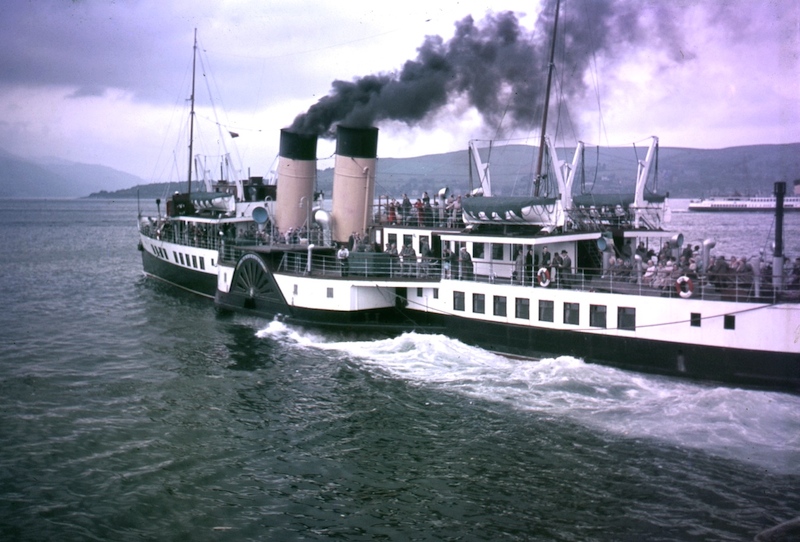
Waverley leaving Gourock c1958, now with white deckhouses but still with LNER hoops on her funnels. The steamer heading upriver on the right is Queen Mary II. Copyright CRSC Douglas Brown Collection
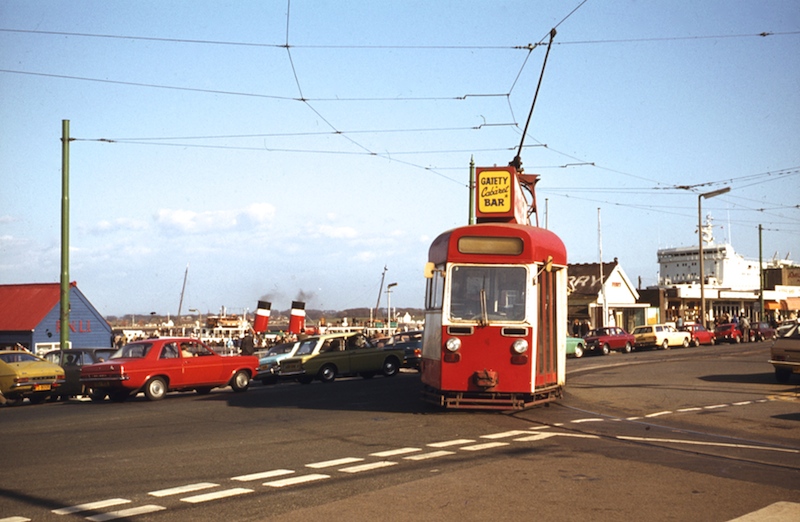
Ambassador for Scotland: Waverley at Fleetwood in April 1980, with a Blackpool tram. Copyright Walter Bowie
Waverley, Last of the Clyde Steamers














